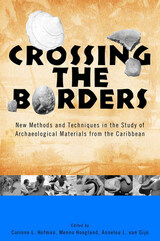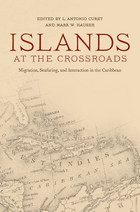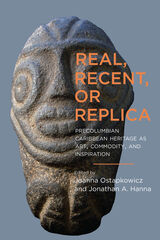3 books by Hoogland, Menno L. P.

Crossing the Borders
New Methods and Techniques in the Study of Archaeological Materials from the Caribbean
Edited by Corinne L. Hofman, Menno Hoogland, and Annelou L. van Gijn
University of Alabama Press, 2008
Explores the application of a selected number of newly emerging methods and techniques
During the past few decades, Caribbean scholars on both sides of the Atlantic have increasingly developed and employed new methods and techniques for the study of archaeological materials. The aim of earlier research in the Caribbean was mainly to define typologies on the basis of pottery and lithic assemblages leading to the establishment of chronological charts for the region, and it was not until the 1980s that the use of technological and functional analyses of artifacts became widespread. The 1990s saw a veritable boom in this field, introducing innovative methods and techniques for analyzing artifacts and human skeletal remains. Innovative approaches included microscopic use-wear analysis, starch residue and phytolith analysis, stable isotope analysis, experimental research, ethnoarchaeological studies, geochemical analyses, and DNA studies.
The purpose of this volume is to describe new methods and techniques in the study of archaeological materials from the Caribbean and to assess possible avenues of mutual benefit and integration. Exploring the advantages and disadvantages in the application of a selected number of newly emerging methods and techniques, each of these approaches is illustrated by a case study. These studies benefited from a diverse array of experience and the international background of the researchers from Canada, the Netherlands, Cuba, Puerto Rico, Martinique, Italy, Mexico, Dominican Republic, England, and the United States who are integral members of the archaeological community of the Caribbean. A background to the study of archaeological materials in the Caribbean since the 1930s is provided in order to contextualize the latest developments in this field.
[more]

Islands at the Crossroads
Migration, Seafaring, and Interaction in the Caribbean
L. Antonio Curet
University of Alabama Press, 2011
A long sequence of social, cultural, and political processes characterizes an ever-dynamic Caribbean history. The Caribbean Basin is home to numerous linguistic and cultural traditions and fluid interactions that often map imperfectly onto former colonial and national traditions. Although much of this contact occurred within the confines of local cultural communities, regions, or islands, they nevertheless also include exchanges between islands, and in some cases, with the surrounding continents. recent research in the pragmatics of seafaring and trade suggests that in many cases long-distance intercultural interactions are crucial elements in shaping the social and cultural dynamics of the local populations.
The contributors to Islands at the Crossroads include scholars from the Caribbean, the United States, and Europe who look beyond cultural boundaries and colonial frontiers to explore the complex and layered ways in which both distant and more intimate sociocultural, political, and economic interactions have shaped Caribbean societies from seven thousand years ago to recent times.
Contributors
Douglas V. Armstrong / Mary Jane Berman / Arie Boomert / Alistair J. Bright / Richard T. Callaghan / L. Antonio Curet / Mark W. Hauser / Corinne L. Hofman / Menno L. P. Hoogland / Kenneth G. Kelly / Sebastiaan Knippenberg / Ingrid Newquist / Isabel C. Rivera-Collazo / Reniel Rodríquez Ramos / Alice V. M. Samson / Peter E. Siegel / Christian Williamson
[more]

Real, Recent, or Replica
Precolumbian Caribbean Heritage as Art, Commodity, and Inspiration
Edited by Joanna Ostapkowicz and Jonathan A. Hanna
University of Alabama Press, 2021
A Choice Outstanding Academic Title, 2022
Examines the largely unexplored topics in Caribbean archaeology of looting of heritage sites, fraudulent artifacts, and illicit trade of archaeological materials
Real, Recent, or Replica: Precolumbian Caribbean Heritage as Art, Commodity, and Inspiration is the first book-length study of its kind to highlight the increasing commodification of Caribbean Precolumbian heritage. Amerindian art, including “Taíno” art, has become highly coveted by collectors, spurring a prolific and increasingly sophisticated black market of forgeries, but also contemporary artistic engagement, openly appreciated as modern artworks taking inspiration from the past. The contributors to this volume contend with difficult subject matter including the continued looting of archaeological sites in the region, the seismic increase of forgeries, and the imbalance of power and economic relations between the producers and consumers of neo-Amerindian art.
The case studies document the considerable time depth of forgeries in the region (since the late nineteenth century), address the policies put in place by Caribbean governments and institutions to safeguard national patrimony, and explore the impact looted and forged artifacts have on how museums and institutions collect and ultimately represent the Caribbean past to their audiences. Overall, the volume emphasizes the continued desire for the “authentic” Precolumbian artifact, no matter the cost. It provides insights for archaeologists, museum professionals, art historians, and collectors to combat illegal trade and support communities in creating sustainable heritage industries.
Examines the largely unexplored topics in Caribbean archaeology of looting of heritage sites, fraudulent artifacts, and illicit trade of archaeological materials
Real, Recent, or Replica: Precolumbian Caribbean Heritage as Art, Commodity, and Inspiration is the first book-length study of its kind to highlight the increasing commodification of Caribbean Precolumbian heritage. Amerindian art, including “Taíno” art, has become highly coveted by collectors, spurring a prolific and increasingly sophisticated black market of forgeries, but also contemporary artistic engagement, openly appreciated as modern artworks taking inspiration from the past. The contributors to this volume contend with difficult subject matter including the continued looting of archaeological sites in the region, the seismic increase of forgeries, and the imbalance of power and economic relations between the producers and consumers of neo-Amerindian art.
The case studies document the considerable time depth of forgeries in the region (since the late nineteenth century), address the policies put in place by Caribbean governments and institutions to safeguard national patrimony, and explore the impact looted and forged artifacts have on how museums and institutions collect and ultimately represent the Caribbean past to their audiences. Overall, the volume emphasizes the continued desire for the “authentic” Precolumbian artifact, no matter the cost. It provides insights for archaeologists, museum professionals, art historians, and collectors to combat illegal trade and support communities in creating sustainable heritage industries.
[more]
READERS
Browse our collection.
PUBLISHERS
See BiblioVault's publisher services.
STUDENT SERVICES
Files for college accessibility offices.
UChicago Accessibility Resources
home | accessibility | search | about | contact us
BiblioVault ® 2001 - 2024
The University of Chicago Press









